Turf Toe - Injury
Turf Toe, which is a layman’s term for a more complex medical term, is usually associated with “Football injuries“, but make no mistake about it, turf toe injuries, on a percentage basis, occur just as often in baseball players as with other athletes. The fact the injury is not as widely publicized in baseball, thus not as well known or recognized, let’s start our examination of the injury from the beginning.
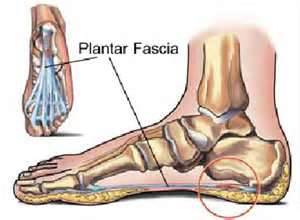
The simplest way to describe turf toe is that it is a sprain of the Main Joint of the big toe and is the result of having the toe hyper extended by the pushing off from the toe, such as exploding into a sprint for a baseball, or having the toe jammed into the turf.
This type of injury skyrocketed in professional sports, including baseball, with the introduction of artificial turf playing fields, which is much harder and less forgiving than natural grass or dirt, thus the name “Turf Toe.”
Anatomy Lesson:
I am no doctor, and assume neither are you, therefore I’ll only touch on the body anatomy which is involved when incurring a turf toe injury.
1. The big toe is made up of 2 joints;
(a.) the metatarsophalangeal joint (MTP) the 1st long bone connected to the foot and toe;
(b.) the phalanx, which is connected to the MTP joint, which is the joint injured in toe turf;
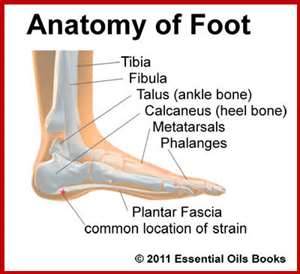
2. The joint is surrounded by body structures which protect and hold the toe in place;
(a.) Plantar plate, prevents the toe from bending too far;
(b.) Collateral ligaments, prevents the toe from going too far sideways;
(c.) Flexor hallucis brevis; a tendon which provides strength;
(d.) Sesamoids, 2 small bones which help provide strength and stability to the forefoot.
The main thing to take away from this anatomy lesson is there’s a whole lot of little things intertwined and dependent on one another to keep the big toe from becoming injured. You can see how an injury to any one of these numerous parts can quickly create a problem.
Rating the Injury:
Similar to rating the degree of seriousness of burns in order to formulated a medical treatment plan for the patient, turf toe injuries are also rated as to the degree of seriousness in order to treat the injury.
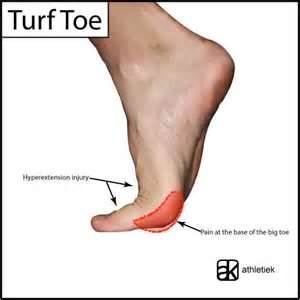
Grade 1:
This is a mild injury where the plantar complex has been stretched and causes pin-point tenderness and a slight swelling of the toe area.
Grade 2:
This is a more severe degree of injury where a partial tearing of the plantar complex has occurred resulting in wide spread tenderness, moderate to increased swelling and is often accompanied with bruising. Movement of the toe is very restricted and painful.
Grade 3:
The plantar complex has been completely torn, resulting in severe tenderness, swelling and extensive bruising of the toe area. It is very difficult and extremely painful to attempt to move the toe.
Normal Cause:
The exact circumstances or sequence of events which create the injury are numerous and vary, but simplistically speaking, the injury most often occurs when:
1. The heel is in the raised position (off the ground) and an external action forces the toe into the ground and creates a hyperextension.
(a.) Sliding hard into a secured base in an awkward foot position, slamming the toe into the bag, can be a case;
(b.) An instantaneous pivot and push off such as a cross over step utilized in base stealing or chasing a hit or thrown baseball can also result in the injury as well as the infamous “freak accident” which occurs daily in our lives.
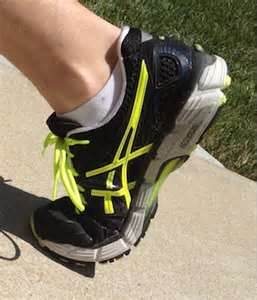
Treatment: First Aid
Utilizing the RICE method is the accepted first step of treatment.
R - Rest, ceasing the sports activity and avoid walking or putting weight on the foot.
I - Use Ice packs in 20 minute intervals, never applying ice directly to the bare skin.
C - Use compression by wrapping the affected area in an elastic bandage to restrict swelling.
E - While resting elevate the leg and foot higher than your heart.
Taking an over the counter anti-inflammation, such as ibuprofen will help reduce the symptoms and provide pain relief.
Serious Injury: Helping Your Doctor
If it is obvious the injury is quite serious, such as serious visible signs or severe pain, or if the symptoms do not improve but persists day after day, professional medical treatment should be sought.
Try to remember, write it down if necessary, the exact situation, what you were doing, which caused the injury, such as “I leaped onto the fence using my foot to push upward in an attempt to catch the ball.“ This can be extremely helpful information to the doctor and help diagnose and streamline a treatment program.
What to Expect:
Sometimes fear of the unknown is worse than the reality of the situation so let’s list the possible things you may encounter when having the medical examination.
1. You’ll be asked questions; remember the written accident description;
2. The doctor will check for swelling and range of movement of the injured toe, sometimes in comparison with the uninjured toe, which will be painful.
Don’t expect any type of pain killer to be administered as the degree of pain experienced is imperative to properly diagnose the degree of injury.
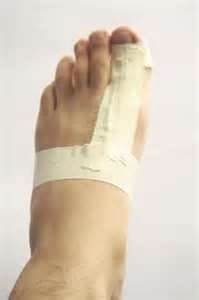
Imaging:
The doctor may order imaging in order to assist or verify the diagnosis.
1. Xrays.
Although a turf toe injury usually involves soft tissue damage, which would not show up on an x-ray, he may want to verify there is no bone injury.
2. MRI - An MRI will show any damage to soft tissue and cartilage, which will be the brunt of the injury.
Surgery:
Required surgery to repair turf toe is very unusual and is only considered in an extreme Grade 3 injury, which involves more damage to the toe area than what is normally associated with turf toe. Such as;
1. Fracture of the sesamoid
2. Vertical instability of the MTP joint
3. Damage to the cartilage
4. A severe tear of the plantar complex
Protection:
The best preventive measure to take to avoid turf toe is to wear the correct type of shoe, which fits properly.
1. Shoes or spikes designed specifically for artificial surfaces offer little to no protection for the foot, because the shoes are specifically designed to be flimsy, for increased speed and mobility. Stay away from this type of shoe if possible.
2. Using proper cleat design for the surface. Most, if not all, amateur leagues play on dirt and grass surfaces, but cleat design can greatly affect the player’s safety by what the cleat can or can not do well on the playing surface.
3. Always be sure the footwear fits properly. Buying footwear too large, in order to grow into them, is a bad idea.
Turf toe injury, is no different than any other type sports injury and can usually be quickly treated and healed. I just wanted to bring it to coaches and parents attention that although it’s normally associated with football, it does most definitely occur in baseball and must not be ignored.
Turf Toe to Little League Baseball Injuries

New! Comments
Have your say about what you just read! Leave me a comment in the box below.